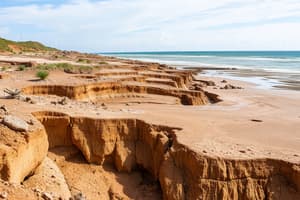Podcast
Questions and Answers
What is the process of moving sediments and other materials from one place to another?
What is the process of moving sediments and other materials from one place to another?
- Deposition
- Sedimentation
- Erosion (correct)
- Accumulation
What type of landform is formed by the deposition of sediments in a fan-shaped pattern?
What type of landform is formed by the deposition of sediments in a fan-shaped pattern?
- Delta
- Valley
- Alluvial fan (correct)
- Canyon
What is the term for the water located within the rocks below Earth's surface?
What is the term for the water located within the rocks below Earth's surface?
- Freshwater
- Rainwater
- Groundwater (correct)
- Surface water
What forces shape a shoreline?
What forces shape a shoreline?
What is formed by the deposition of sediments in a layer over flooded land?
What is formed by the deposition of sediments in a layer over flooded land?
What is the term for the place where land and a body of water meet?
What is the term for the place where land and a body of water meet?
How do streams create canyons and valleys?
How do streams create canyons and valleys?
What is the primary difference between a delta and an alluvial fan?
What is the primary difference between a delta and an alluvial fan?
What is responsible for shaping a shoreline?
What is responsible for shaping a shoreline?
What is the term for a flat area formed by the deposition of sediment over flooded land?
What is the term for a flat area formed by the deposition of sediment over flooded land?
What is an example of a coastal landform made by erosion?
What is an example of a coastal landform made by erosion?
How do streams deposit their loads?
How do streams deposit their loads?
Flashcards are hidden until you start studying
Study Notes
Erosion and Deposition
- Erosion is the process of moving sediments and materials from one place to another.
- Deposition is the process of dropping eroded material.
Streams and Landforms
- Streams can create canyons and valleys through erosion, such as the Colorado River creating the Grand Canyon.
- Floodplains are formed through deposition, where layers of sediments are deposited over flooded land, creating a flat area.
- Deltas are fan-shaped deposits that form in water, while alluvial fans are fan-shaped deposits that form on dry land.
- Both deltas and alluvial fans are formed through deposition.
Groundwater
- Groundwater is the water located within rocks below Earth's surface.
- Groundwater can shape landforms through both erosion and deposition.
Coastal Landforms
- Shoreline is the place where land and a body of water meet.
- Waves and currents are forces that shape a shoreline.
- Coastal landforms can be formed through both erosion and deposition.
- Examples of coastal landforms made by erosion include cliffs and arches.
- Examples of coastal landforms made by deposition include beaches and spits.
Erosion and Deposition
- Erosion is the process of moving sediments and materials from one place to another.
- Deposition is the process of dropping eroded material.
Streams and Landforms
- Streams can create canyons and valleys through erosion, such as the Colorado River creating the Grand Canyon.
- Floodplains are formed through deposition, where layers of sediments are deposited over flooded land, creating a flat area.
- Deltas are fan-shaped deposits that form in water, while alluvial fans are fan-shaped deposits that form on dry land.
- Both deltas and alluvial fans are formed through deposition.
Groundwater
- Groundwater is the water located within rocks below Earth's surface.
- Groundwater can shape landforms through both erosion and deposition.
Coastal Landforms
- Shoreline is the place where land and a body of water meet.
- Waves and currents are forces that shape a shoreline.
- Coastal landforms can be formed through both erosion and deposition.
- Examples of coastal landforms made by erosion include cliffs and arches.
- Examples of coastal landforms made by deposition include beaches and spits.
Studying That Suits You
Use AI to generate personalized quizzes and flashcards to suit your learning preferences.




